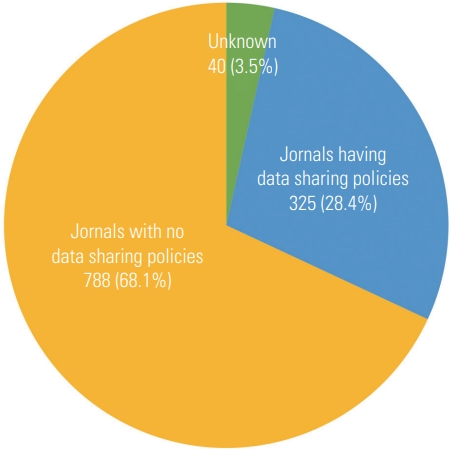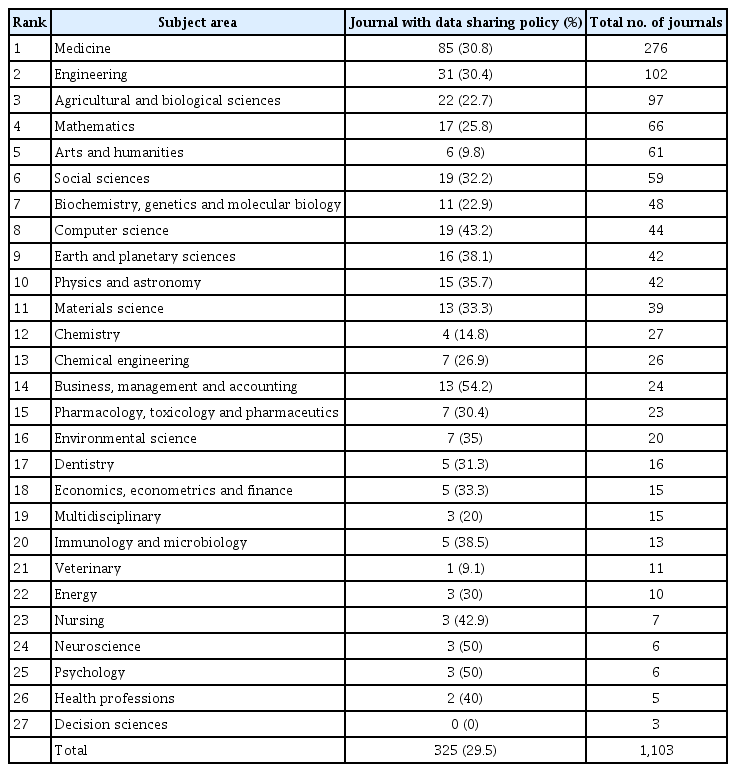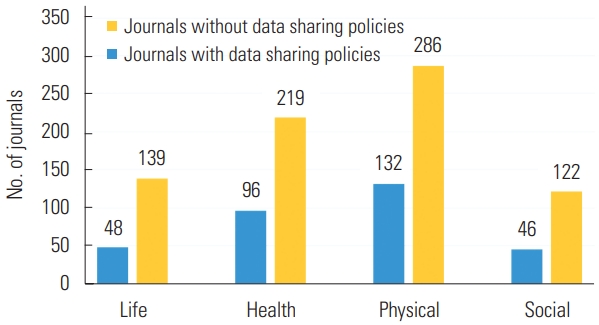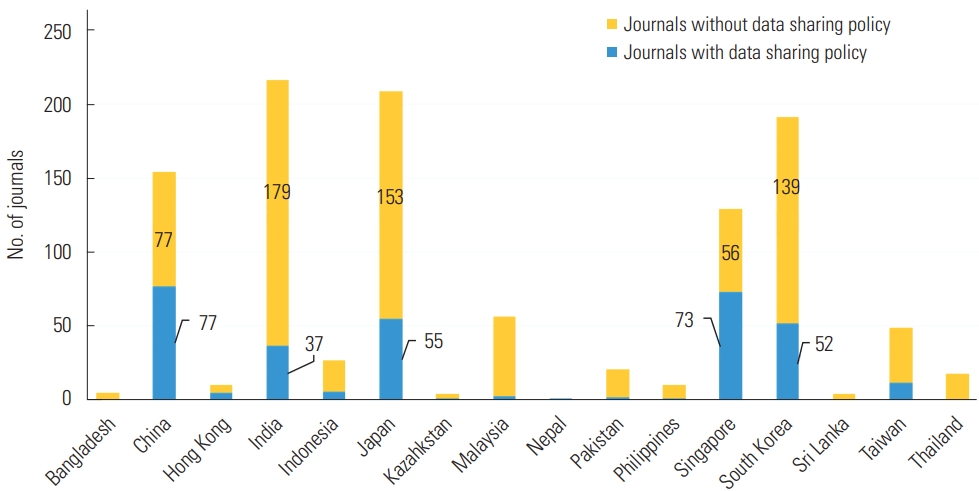Status and factors associated with the adoption of data sharing policies in Asian journals
Article information
Abstract
Purpose
This study investigated the current status and factors associated with adopting data sharing policies in Asian journals. Data sharing policies vary by country and region, and few studies have examined the trends and factors related to these policies in journals across the Asian region.
Methods
The 2020 Scimago Journal and Country Rank was used to download data about 1,143 Asian journals indexed in Web of Science. Excluding 40 journals inaccessible via the Internet or without English-language websites and author guidelines, 1,103 journals were analyzed through descriptive statistical analyses and the chi-square test.
Results
Of the 1,103 journals, 325 (29.5%) had data sharing policies, showing a moderate level of policy adoption among Asian journals. The results of the chi-square test suggested that the impact factor and publisher type (whether a publisher was commercial) were significantly associated with the presence of data sharing policies in journals, but subject categories were not identified as a significant factor. Regarding the strength of data sharing policies, most journals provided policies that only encouraged data sharing.
Conclusion
Policies only encouraging data sharing are unlikely to lead to actual data sharing; thus, considering varying levels of policy strength and effective ways to induce authors’ compliance with the policies is important. Further research needs to examine other factors affecting the presence or strength of data sharing policies.
Introduction
Background/rationale
The role of journals in data sharing is being increasingly emphasized. Journals are expected to foster a culture of open science by establishing and implementing data sharing policies. One study has suggested that journal data sharing requirements pressure authors to participate in data sharing practices, thereby affecting data sharing norms and practices [1]. Several studies have investigated publisher or journal data sharing policies. A recent literature review conducted by Woods and Pinfield [2] stated that these studies have been done at three levels: the publisher level, the field- or discipline-specific level, or the individual journal level.
Research on journals’ data sharing policies has also suggested several factors associated with the existence or strength of these policies. The identified factors significantly associated with policy presence or strength include the impact factor, discipline, type of journal publisher, and the geographic location of the publisher. The impact factor has been the most frequently mentioned factor, as journals with higher impact factors are more likely to have data sharing policies [3–5]. Regarding disciplines, it has been suggested that journals in the life sciences tend to adopt data sharing policies [4] or have stronger data sharing policies than those in other disciplines [6–8].
The publisher type—that is, whether a publisher is commercial—is also a relevant factor. A recent study has suggested that journals with commercial publishers are more likely to have data sharing policies than those with non-commercial publishers [7]. This finding, however, contrasts with those of previous studies conducted 10 years and more ago [5,9]. A possible interpretation for this difference involves changes in commercial publishers’ attitudes toward data sharing, which have led to active support for journals having data sharing policies.
Moreover, the geographic location of the publisher would be an influential factor because the regulations that govern data sharing practices vary across countries and regions, leading to substantial differences in journals’ data sharing policies [8,10]. Nevertheless, limited studies have examined the countries or regions of publishers as a factor related to the presence of data sharing policies in journals. Especially regarding Asian journals, only a few studies have investigated the data sharing policies of journals in individual Asian countries, such as Japan [11], South Korea [10,12], and China [8]. Little research, however, has been conducted on the data sharing policies of journals published across the Asian region.
Objectives
This study aimed to investigate the current status of data sharing policies and factors associated with them in terms of journals published in the Asian region. The analysis was based on data from 1,103 journals from 16 Asian countries. The research questions included the following: To what extent do Asian journals have data sharing policies? Which factors are associated with the presence or absence of data sharing policies in Asian journals? How enforceable are the data sharing policies of Asian journals?
Methods
Ethics statement
Neither approval by the institutional review board nor obtainment of the informed consent was required since this was a literature-based study.
Study design
This was a descriptive study based on journals’ policies.
Data collection methods
Data about Asian journals were downloaded from the 2020 Scimago Journal and Country Rank (SJR). The SJR website contains several search parameters, such as region and material type, including journals, book series, and conference proceedings. We limited the search to the Asian region and set the material type to journals. Specifically, we only searched for Web of Science journals because Web of Science is one of the most respected databases that index leading scholarly articles in journals and elsewhere. Based on these parameters, 1,143 journals were identified. The data collected for each journal included the following: title, SJR quartile, country, publisher, and subject category (Dataset 1).
We each took half of the 1,143 journals and separately identified data sharing policies by visiting each journal’s website and searching for the policies, which were mostly located in the guidelines for authors. In the current study, journals with data sharing policies refer to those journals that explicitly require or encourage data sharing or data availability statements. This definition does not include journals that only provide supplementary material policies without mentioning data sharing.
Out of 1,143 journals, 40 could not be examined because they had inaccessible websites, did not have English-language websites, or had no guidelines for authors (Fig. 1). The remaining 1,103 journals were subsequently analyzed. As a result, we identified 325 journals that had data sharing policies.
Variables
We primarily compared Asian journals with data sharing policies to those without such policies in relation to four aspects: subject area, country, SJR quartile, and publisher type. Thus, the units of study were journals published in the Asian region.
Data analysis
Descriptive statistical analyses were performed to compare the numbers of journals with and without data sharing policies by subject area, country, SJR quartile, and publisher type. The number and percentage of journals with data sharing policies in each subject area, country, SJR quartile, and publisher type were also examined. In addition, the chi-square test, as an inferential statistical analysis, was performed to determine whether there was a significant association between the presence of data journal policies in Asian journals and the following factors: subject area, SJR quartile, and publisher type. Stata SE ver. 17.0 (StataCorp LLC, College Station, TX, USA) was used to perform the analyses.
Results
Subject areas
The original dataset downloaded from the 2020 SJR provided multiple subject categories for each journal based on over 300 sub-subject areas of Scopus. These minor subject areas can aggregate up to 27 Scopus subject areas. For a better presentation of subject categories, one of the 27 subject areas, corresponding to the first-listed sub-subject area of each journal, was assigned to each individual journal. Fig. 2 shows the number of journals with and without data sharing policies by 27 Scopus subject areas.
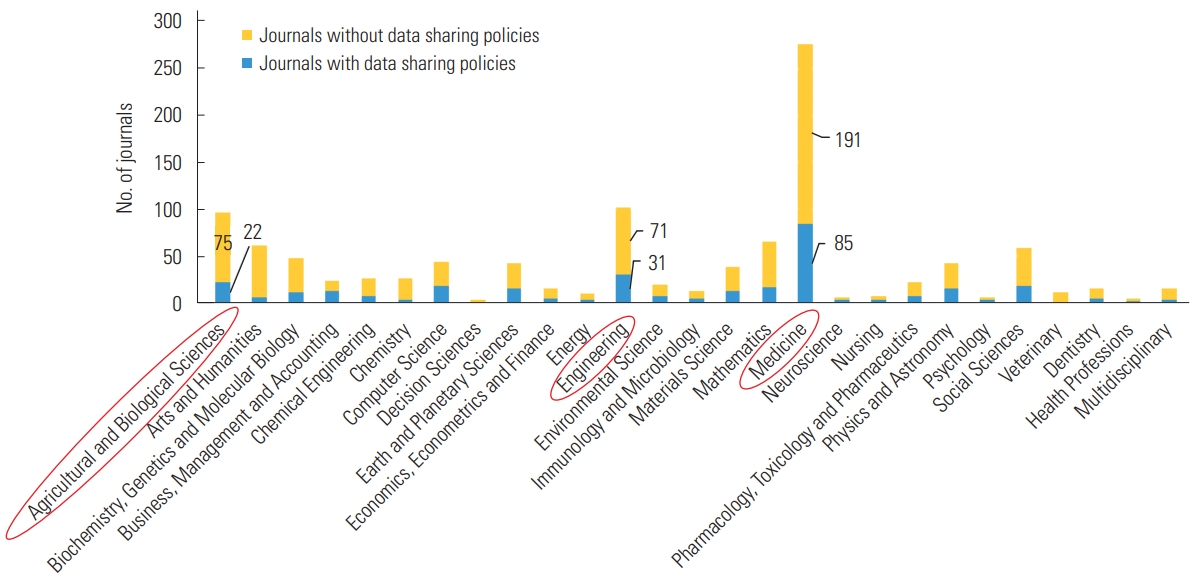
The number of journals with vs. without data sharing policies by 27 Scopus subject areas. Three subject areas (medicine, engineering, and agricultural and biological sciences) were the most common in Asian journals.
According to Fig. 2, three subject areas—medicine, engineering, and agricultural and biological sciences—were the most common in Asian journals. Specifically, the greatest number of journals were in medicine (25.0%, 276 out of 1,103). We also investigated the number and percentage of journals with data sharing policies in each subject area. The subject areas were sorted by the total number of journals in each subject (Table 1). The 18 bolded subject areas in Table 1 indicate those with higher percentages of journals with data sharing policies than the average (29.5%, 325 of 1,103). In particular, the subject areas where more than 40% to 50% of the journals had data sharing policies included computer science, business, management and accounting, nursing, neuroscience, psychology, and health professions.
The 27 Scopus subject areas, except for multidisciplinary journals, can also be grouped by the four largest subject categories: life, health, physical, and social sciences [13]. Excluding 15 multidisciplinary journals (three with data sharing policies), 1,088 journals were categorized into four subjects. Fig. 3 shows the distribution of the number of journals with versus without data sharing policies according to the four categories. The percentages of 322 journals with data sharing policies were 25.7% in life sciences, 30.5% in health sciences, 31.6% in physical sciences, and 27.4% in social sciences. Unlike the findings in a previous study [4], the extent of adopting data sharing policies by life science journals was lower than that of journals in other subject categories. The chi-square test was conducted to examine whether there was a significant association between the presence of data sharing policies in journals and the subject categories. However, no significant association was identified between the two variables (Χ2 (3) = 2.69, P = 0.44).
Countries
The journals examined in the current study were distributed across 16 Asian countries. The highest number of journals were published in India, followed by Japan, South Korea, China, and Singapore. The numbers of journals from Malaysia and Taiwan were also higher than the others (Fig. 4).
In an analysis of the number and percentage of journals with data sharing policies in each country (Table 2), although the total number of Indian journals was the highest at 216, only 37 of these journals (17.1%) had data sharing policies. The percentages of journals with data sharing policies from Japan and South Korea were between 26% and 27%, which were slightly below the average. However, the percentages of journals with data sharing policies from China, Singapore, and Hong Kong were approximately 50% or higher. This indicates that the journals in these countries or regions were more likely to have adopted data sharing policies than those in other countries.
SJR quartiles
We examined the number of journals with data sharing policies and those without based on SJR quartiles. As shown in Fig. 5, the number of Q1 journals with data sharing policies was similar to that of Q1 journals without the policies, but the proportions of the journals with data sharing policies in Q2, Q3, and Q4 (36.6%, 21.4%, and 13.0%, respectively) were much smaller than that of journals in Q1 (50.8%). The chisquare test showed that there was a significant association between the presence of data sharing policies in a journal and its SJR quartile (Χ2 (3)= 84.47, P< 0.001). This result and the pattern of the distribution in Fig. 5 indicate that journals with higher impact factors were more likely to have data sharing policies.
Publisher type
Table 3 presents the number and percentage of journals with data sharing policies from each commercial and non-commercial publisher. Of the 470 commercial publishers, Springer published the greatest number of journals was published (118, 25.1%), but the proportion of their journals with data sharing policies was lower than average. Except for Techno Press and the “Other” category, most commercial publishers showed a much higher percentage of journals with data sharing policies than average (29.5%). Among the 633 non-commercial publishers, academic societies published the most journals (231, 36.5%), followed by universities (182, 28.8%). The journals published by academic societies showed an approximately average percentage of journals with data sharing policies. The percentages of journals with data sharing policies published by associations, academies, and the journals themselves were slightly higher than average.

The number and percentage of journals with data sharing policies in each commercial and non-commercial publisher
A comparison between the number of journals with data sharing policies and that of journals without data sharing policies by publisher type (commercial vs. non-commercial) is presented in Fig. 6. The proportion of commercial publishers’ journals with data sharing policies (37.0%) was higher than that of non-commercial publishers’ journals (23.9%). The chi-square test showed a significant association between the presence of data sharing policies in a journal and the type of publisher (Χ2 (1) = 22.72, P < 0.001). The findings suggest that journals with commercial publishers were more likely to have data sharing policies than those with non-commercial publishers.
Strength of data sharing policies
Commercial publishers such as Wiley or Springer provide various levels, or strengths, of data sharing policies. According to Wiley’s categories of data sharing policies [14], for example, a level 1 policy s only encourages data sharing, which means that data availability statements, actual data sharing, and data peer review are optional. Level 2 requires data availability statements only. Level 3 mandates data availability statements and actual data sharing. Level 4, which is the strongest policy, mandates data sharing with peer review of data. Based on the policy levels, the vast majority (74.2%) of the data sharing policies in the 325 Asian journals only encouraged data sharing. Fifty-two (16.0%) required data availability statements, and 32 (9.8%) mandated actual data sharing.
Table 4 shows examples of policy statements at different levels. An example of the level 1 policy mentions encouraging data sharing and data citation. An example of a level 2 policy notes that all manuscripts submitted to the journal must include a data availability statement. An example of a level 3 policy shows that data deposition and data availability statements are mandatory.
Discussion
Key results
The current study suggested that the proportion of Asian journals with data sharing policies was less than one-third (29.5%), indicating that journals in the Asian region have gradually adopted these policies. However, the proportions differed by subject area, country of publication, impact factor, and publisher type, all of which might be considered factors related to the adoption of the policies. Based on the chi-square test, the current study identified the impact factor and publisher type as significant factors associated with the presence of data sharing policies in Asian journals. These findings are consistent with those of other studies [3–5,7]. However, a significant association was not found between the journals’ adoption of the policies and the four subject categories of Scopus. In addition, most of the Asian journals examined in the present study only encouraged data sharing. A small portion of the journals required data availability statements.
Interpretation
Asian journals with higher impact factors were more likely to adopt data sharing policies. This may be the case because journals with higher impact factors would receive more interest from researchers and have more pressure to establish policies that address current issues in scholarly communication. They also tend to have more resources than other journals to build policies [4]. Asian journals with commercial publishers were also found to be more likely to have data sharing policies than those with non-commercial publishers. Commercial publishers’ active promotion and support of data sharing would make journals adopt data sharing policies [7].
However, subject areas were not identified as a significant factor. The percentage of life science journals with data sharing policies was lower than that of journals in the health, physical, and even social sciences. This is inconsistent with the results from a previous study [4], which might be explained by the possibility that journals in disciplines other than life sciences have become more aware of data sharing recently and have adopted these policies as much as life science journals have. In terms of countries, higher percentages of journals from China, Hong Kong, and Singapore were found to adopt data sharing policies than those from other countries. Regulations and policies requiring data sharing recently established by government bodies in China [8] and Singapore [15] may have facilitated the establishment of data sharing policies by journals in these countries.
The strength of data sharing policies in Asian journals was found to be generally low, with most journals only encouraging the submission of data availability statements and actual data sharing. Data availability statements were found to be required by around 26% of the 325 journals; however, another study has suggested that the requirement of data availability statements does not necessarily lead to actual data sharing [16]. This implies that policies that only encourage data sharing would not have much of an effect on the real action of sharing data. Thus, it is important to consider varying levels of policy strength and effective ways to induce authors’ compliance with the policies.
Limitations
We performed the chi-square test, which only evaluated a single variable and, thus, did not take into account the interaction among subject category, SJR quartile, and type of publisher.
Conclusion
The Asian journals examined in the current study adopted data sharing policies to a moderate extent, and most journals’ policies only encouraged data sharing. Considering a more effective policy approach to journal authors’ participation in data sharing is necessary. The impact factor and publishing type of Asian journals were found to be significant factors associated with journals having data sharing policies. Future research needs to examine other factors that affect the presence and strength of data sharing policies.
Notes
Conflict of Interest
No potential conflict of interest relevant to this article was reported.
Data Availability
Dataset file is available from the Harvard Dataverse at: https://doi.org/10.7910/DVN/XDVZSB
Dataset 1. Raw data of Web of Science journals published in Asiatic area retrieved from the 2020 Scimago Journal and Country Rank, including data sharing policies, subject area, country, SJR quartile, and publisher type.
Funding
The authors received no financial support for this article.

